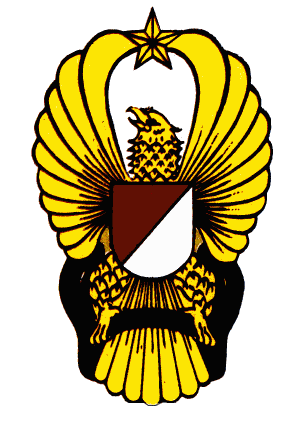





 Since the 01 April 1999 separation of POLRI, the Indonesian National Police, from ABRI, the Indonesian armed forces, the army has begun to use its former name, Tentara Nasional Indonesia or National Army of Indonesia (TNI); the term is increasingly being used instead of ABRI. The ground forces are presently termed Tentara Nasional Indonesia Angkatan Darat.
Since the 01 April 1999 separation of POLRI, the Indonesian National Police, from ABRI, the Indonesian armed forces, the army has begun to use its former name, Tentara Nasional Indonesia or National Army of Indonesia (TNI); the term is increasingly being used instead of ABRI. The ground forces are presently termed Tentara Nasional Indonesia Angkatan Darat.
The Army of the Republic of Indonesia (ADRI) historically has been the dominant service, with administrative control of the armed forces resting with the army chief of staff, in 1992 a four-star general. His staff included a vice chief of staff, an inspector general, and assistant chiefs of staff for logistics, operations, personnel, planning and budget, security, and territorial affairs. Total army strength, which had not changed substantially during the New Order era, as of 1992 was some 217,000, not including several thousand in nonmilitary positions throughout the government.
The chief of staff was responsible for personnel, training, administration, and logistical support of the army, but he did not exercise direct authority over the ten KODAMs, the regional commands of the army that reported directly to the commander in chief. Commanders and staff of each KODAM were responsible for administration, logistics, personnel, training, and the general welfare of assigned and attached combat units. Each Kodam was divided into successively smaller administrative units. These included the Military Resort (Garrison) Command (KOREM); Military District Command (KODIM); and Military Subdistrict Command (KORAMIL). At the bottom of the structure, noncommissioned officers (NCOs) were assigned to every village in the country.
The geographic extent of the army KODAM in the early 1990s was as follows: KODAM I, Special Region of Aceh and Sumatera Utara, Sumatera Barat, and Riau provinces; KODAM II, Jambi, Bengkulu, Sumatera Selatan, and Lampung provinces; KODAM III, Jawa Barat Province; KODAM IV, Jawa Tengah Province and the Special Region of Yogyakarta; KODAM V, Jawa Timur Province; KODAM VI, the four provinces of Kalimantan; KODAM VII, the four provinces of Sulawesi; KODAM VIII, Maluku and Irian Jaya provinces; KODAM IX, Bali, Nusa Tenggara Timur, Nusa Tenggara Barat, and Timor Timur provinces; and KODAM Jaya Jakarta, the Special Capital City Region of Jakarta.
![[PDF]](id05_04b.gif)
Approximately two-thirds of the army was engaged in the national defense aspect of the armed forces' dwifungsi mission. Operations were rarely, if ever, conducted in any formation larger than a battalion. Each Korem had control of at least one battalion and one or more battalions came under the direct control of the Kodam. Army doctrine differentiated between tactical battalions, which were found in Kostrad and at least one quick reaction force battalion for each Kodam; and territorial battalions, which made up the majority of the units assigned to the ten Kodams. Each battalion had a strength of nearly 700 men, and personnel programs within a fixed staffing size called for recruitment of sufficient numbers to bring chronically understrength units up to authorized levels. Some of these forces were occasionally assigned for temporary missions to Kostrad or Kopassus.
The army had its own small air arm that performed liaison and limited transport duties. It flew one helicopter squadron and one composite squadron composed mostly of light aircraft and small transports, such as the domestically produced CASA 235.
Factionalism within the army leadership, once a severe problem, no longer disrupted operations in the early 1990s. Traditional divisional identification continued to have some significance, however, especially in regard to that developed in the former Siliwangi, Diponegoro, and Brawijaya divisions, which covered western, central, and eastern Java, respectively, during the war of independence and the years immediately thereafter. The detachment of the Jakarta area from the control of the Siliwangi division and the restructuring of the army from a divisional basis to the territorial Kodam system diffused the powers of the divisions and eliminated warlordism.
Most of the army personnel not assigned to combat formations were involved in carrying out the social and developmental portions of the armed forces' dwifungsi mission. Many were attached to the Kodams as support elements, performing intelligence and internal security functions, and maintaining liaison with local officials charged with implementing the government's policies. Some military personnel filled civilian government positions from national and province levels down to the district, subdistrict, or village level. A large portion of the army's territorial forces participated in ABRI civic action projects, such as the nationally directed ABRI Masuk Desa program and locally directed programs at the Kodam level, as part of their mission to promote national development. They constructed roads, bridges, and public buildings, provided medical service in remote areas, and worked to improve rural conditions. The military's civic action mission received added attention after 1983 as part of a program designed to address the problems of a perceived growing gap between ABRI and the civilian population.
By 1992 virtually all of the army's heavy Soviet- or East European-origin equipment had been eliminated and replaced by equipment produced indigenously or purchased from Western countries. Because of funding constraints, emphasis was placed on maintenance and rehabilitation of older equipment. The mainstay of the armored force was the French-built AMX-13 light tank and AMX-VCI reconditioned armored personnel carriers, mostly acquired in the late 1970s. The nation's small arms industry supplied nearly all of the army's small arms requirements, although a substantial number of M-16 rifles purchased from the United States in the 1980s remained in the inventory. Domestically produced arms included FMC rifles, submachine guns, and machine guns made under Belgian-licensed production. Ammunition was in short supply.
Although army recruits received their basic training in a central training facility located in each Kodam area, specialist corps training was provided at the appropriate national corps centers. NCOs were required to attend training courses and to pass examinations in their fields prior to promotion.
